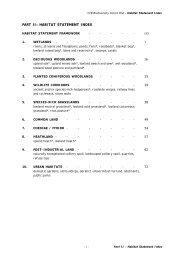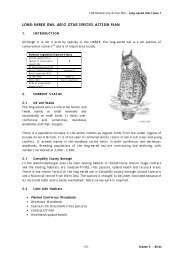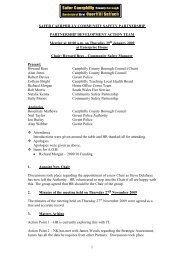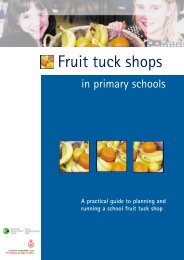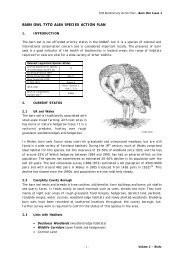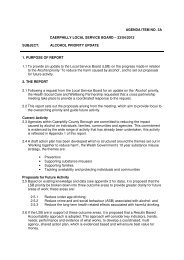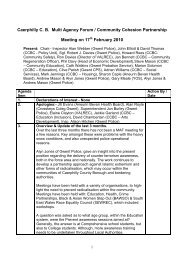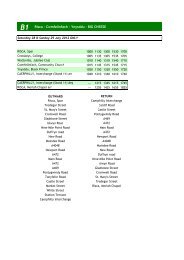SLOW WORM AND COMMON LIZARD SPECIES ACTION PLAN
SLOW WORM AND COMMON LIZARD SPECIES ACTION PLAN
SLOW WORM AND COMMON LIZARD SPECIES ACTION PLAN
You also want an ePaper? Increase the reach of your titles
YUMPU automatically turns print PDFs into web optimized ePapers that Google loves.
CCB Biodiversity Action Plan – Slow Worm and Common Lizard Issue 1<strong>SLOW</strong> <strong>WORM</strong> <strong>AND</strong> <strong>COMMON</strong> <strong>LIZARD</strong> <strong>SPECIES</strong> <strong>ACTION</strong> <strong>PLAN</strong>1. INTRODUCTIONThe slow worm (Anguis fragilis) is one of only three species of lizard found in the UK. It isunusual in that it is legless, bearing a superficial resemblance to a snake. It has undoubtedlysuffered a population decline over the last few decades and for this reason, as well as being oneof the few reptiles often found by children on nature rambles, it has been included in a localaction plan. The common lizard (Lacerta vivipara) is similar to the slow worm in many of itsrequirements and pressures, and is therefore included in this species action plan.Relevant Legislation/Species Statuspriority species (P) orspecies of conservationconcern (S) 39slow worm andcommon lizardEC Habitats Directive -Conservation Regs 1994 -Berne Convention (1982) -Bonn Convention (1979) -CITES (1975) -WCA (1981) Sch. 5S2. CURRENT STATUSslow worm © CCBC 20022.1 UK and WalesSlow worms were ubiquitous in the UK until afew decades ago. There seems to have been asignificant decline in numbers, although thisis based mainly on anecdotal evidence. WithinWales, the species is widespread, butappears to be in decline. Slow worms likewell-vegetated areas with good cover frompredation. They are very rarely seen in theopen, but are often found beneath steelsheets. These may be placed in areas to helpconfirm the presence of this species.common lizard © CCBC 2002Although secretive slow worms seldom flee before they are discovered. They are easilydistinguished from British snakes by their smooth, almost cylindrical body, very small scales anduniform grey or brown coloration. Like many other lizards, slow worms shed their tails whenstressed, and if capture is necessary, they should be handled with great care. Slow worms areovoviviparous (the method of reproduction in which the young develop from eggs retained in themother's body), with eggs hatching on laying to reveal coppery gold young with bold dark brownsides.Common lizards are agile, alert and extremely fast when warm. They rely on cryptic camouflage,lying motionless before fleeing to cover. This rapid movement is often all that betrays theirpresence. Common lizards are often found along railway lines and in the vicinity of old dry-stonewalls, in which they hibernate (not communally). They are active at lower temperatures than thegrass snake, though not as low as the adder, basking between 9 o C and 18 o C. Common lizards aremuch less easily observed than the slow worm and for that reason are less commonly recorded on a- 9 - Volume 2 - Reptiles
CCB Biodiversity Action Plan – Slow Worm and Common Lizard Issue 1site. However, this species is found throughout the UK and is notable in being Ireland's onlyreptile. Within Wales, it is often found along old railway lines where the bare ballast providesbasking and hunting sites.Surveys for both species ought to be undertaken during the months April/May and September,when there is adequate sun but the nights are cool enough to require basking during the day. Theoptimum season is spring when there is an increase in mating activity and the best times of day are0900 to 1100, and 1600 to 1900, when reptiles are most likely to be basking in open locations. Mostreptiles are deaf to a large part of a human's audible range, but are easily alerted by heavyfootfalls and sudden dramatic movements.2.2 Caerphilly County BoroughBoth species are widespread within the county borough, although it is likely that both havesuffered a decline in numbers over recent years. Old industrial sites and railway lines are foundthroughout the county borough and may be locally important for these species. Further surveys arerequired to confirm the status of the species in the county borough2.3 Links with HabitatsThese species require a varied diet of invertebrates, which may be found in most habitats. Theyboth require a degree of direct sunlight, although the slow worm lies beneath dead vegetation,scrap-metal and other rubbish to receive the heat indirectly. All Habitat Statements/Action Plansshould consider whether these species are present.• Wildlife Corridors (hedgerows railway lines, stone walls)• Post-Industrial Land• Common Land• Urban Habitats3. CURRENT FACTORS AFFECTING THE <strong>SPECIES</strong>• Loss of suitable habitat due to development, natural succession, etc.• Loss of suitable hibernation sites due to decline in traditional farm practices (less long-termstorage of manure, loss of dry-stone walls).• Persecution, particularly of the slow worm.• Probable locally high rates of predation by domestic cats.4. CURRENT <strong>ACTION</strong>4.1 Other than small-scale educational projects and talks, no action is currently taking placewithin the borough.5. OBJECTIVES <strong>AND</strong> TARGETS5.1 UK Objectives and TargetsNot applicable to these species.- 10 - Volume 2 - Reptiles
CCB Biodiversity Action Plan – Slow Worm and Common Lizard Issue 15.2 Caerphilly Objectives and Targets5.2.1 Obtain quantitative data on location and numbers of both species through local knowledge,historical evidence and survey.5.2.2 Halt the probable decline of these species and monitor present sites for possible threats tothe population.5.2.3 Use every opportunity to promote the conservation of, and improve public conception ofreptiles.5.2.4 Improve existing habitats which may be suitable for future species colonisation.6. <strong>ACTION</strong> <strong>AND</strong> KEY PARTNERSAction6.1 Policy and Legislation6.1.1 Seek to designate sites withthree or more species of breedingreptiles as SINC.6.2 Site Safeguard and Management6.2.1 Prevent loss or degradation ofexisting sites.6.2.2 Encourage provision for reptileson any new habitat developments, forexample, school grounds.6.3 Species Management and Protection6.3.1 Encourage, through provision ofsuitable cover, the colonisation of newareas by these species.6.3.2 Continue to implement wildlifelegislation.6.4 Advisory6.4.1 Raise awareness of theconservation requirements of thesespecies among landowners andmanagers.6.4.2 Provide a support and problemsolving service to landowners,especially allotment owners, onmethods of management sympathetic toreptiles.6.5 Future Research and Monitoring6.5.1 Set up a county database forreptiles, and support the setting up ofa Local Record Centre to hold and giveaccess to useful information.6.5.1 Carry out surveys to ascertainsites and population sizes and inputthe data into the county boroughdatabase.Key PartnersYear to be complete or in place by:Lead Partners 2OO3 4 5 6 7 8 9 10 11CCBC - üCBP - üCCBCCBPGwentPoliceGwk CMCSGWT GLWT(CCBC CMCSGWT GLWT)-üCBP - üCBP(CMCS)CCBCCBPAllotmentsocietieslandowners(GWT GLWTCMCS CCBC)üü ü ü ü ü ü ü ü üüü ü ü- 11 - Volume 2 - Reptiles
CCB Biodiversity Action Plan – Slow Worm and Common Lizard Issue 1Action6.6 Communications and Publicity6.6.1 Promote reptile conservation andimprove public image through eventsand activities.6.6.2 Liaise with local wildlife groupsto encourage reptile awareness.Key PartnersYear to be complete or in place by:Lead Partners 2OO3 4 5 6 7 8 9 10 11CBP - ü ü ü ü ü ü ü ü üCBP local groups ü ü ü ü ü ü ü ü ü- 12 - Volume 2 - Reptiles



